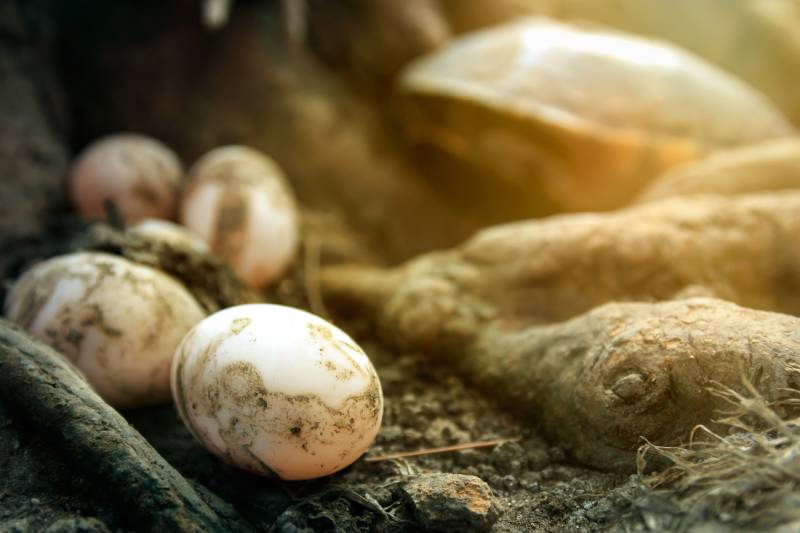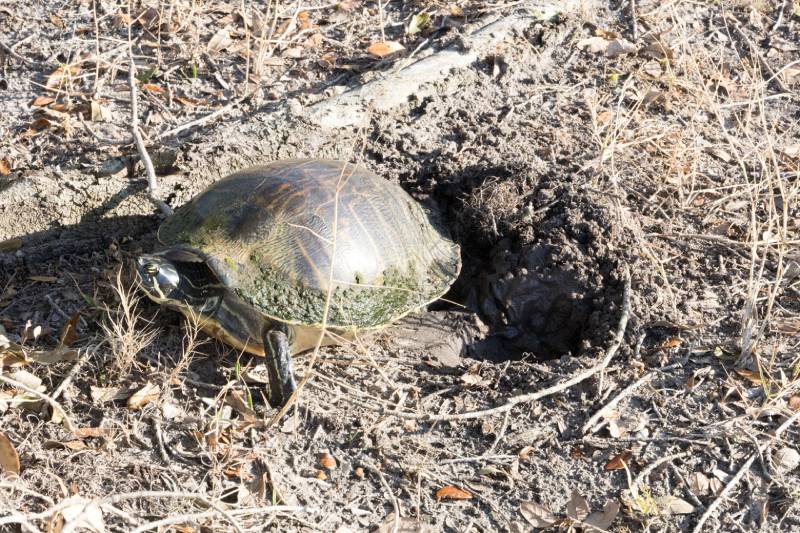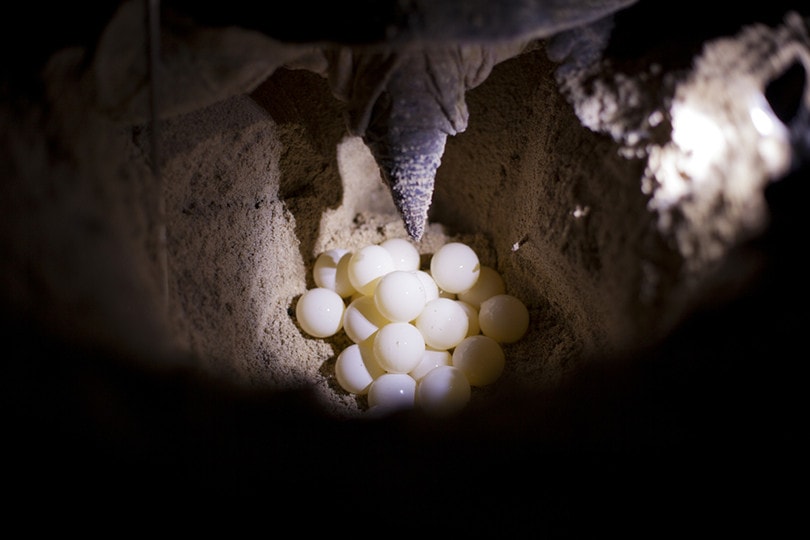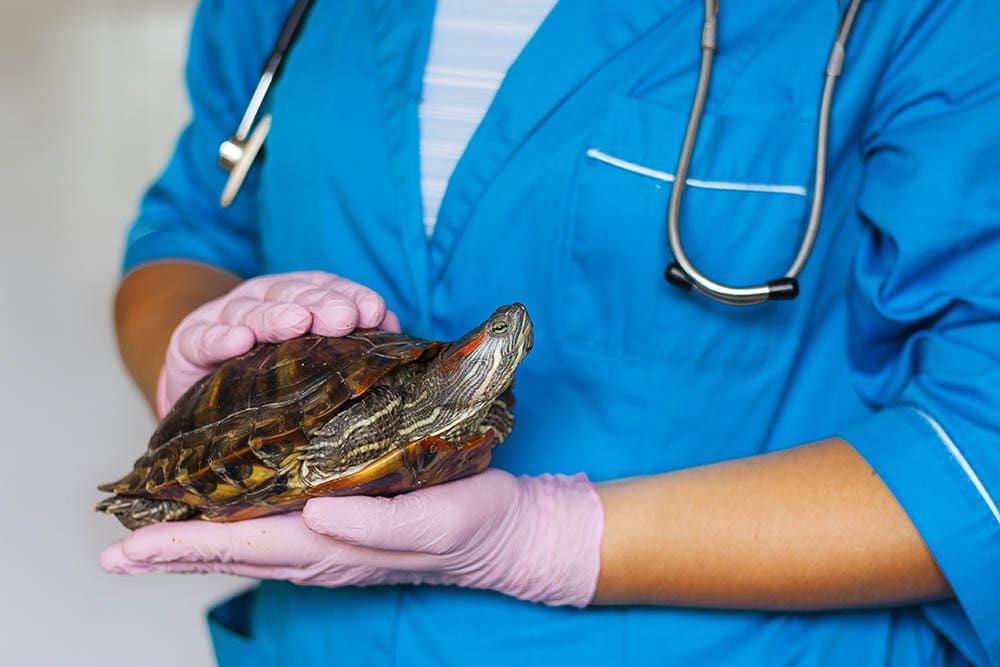
Click to Skip Ahead
Has your turtle just laid eggs and you are excitedly waiting for them to hatch? Unlike mammals that have a fairly predictable gestation period, the incubation period for turtle eggs depends on nest conditions, temperature, humidity levels, turtle species, and more. The average incubation period is between 60 to 120 days, but in most cases, you should expect to be seeing tiny turtles within 90 days.
So, if you’ve provided optimum conditions, all you can do is stand by and wait for those hatchlings to make their appearance. The following article will give you more information about the incubation period of turtle eggs, what happens when they hatch, and how to ensure you know what to do if your pet turtle lays eggs.
How Long Do Turtles Take to Hatch?
There are many species of turtle, each with different habitat requirements, nesting conditions and incubation periods. In this article, we will look only at aquatic turtles, including freshwater turtles or terrapins, and sea turtles. Tortoises are quite different again, so we will leave them to another day. To get an idea of the range of nesting habits and incubation times, let’s take a look at some examples:
Box Turtles
Box turtles are a popular pet, and are something of an “in-between” species. Like tortoises, they spend most of their time on land, and have a domed shell, rather than the flatter shells of aquatic turtles. They prefer habitats with moisture and water bodies, and have webbed feet like terrapins. They can live up to 20 years with proper care. The eggs of these turtles take around 2 to 3 months to hatch.
Even after hatching, you may not see the hatchings for some time. If the eggs hatch in summer, they remain in their nest for a short period before appearing on the surface. If hatched in, or just before winter, the hatchlings will stay in their nest until spring. After hatching, the offspring are on their own without any adult supervision.

Red-Eared Sliders
The courtship of terrapins involves some vigorous underwater dancing from the males of the species, flickering their hind feet to release pheromones towards the female in the hopes of winning her over. They usually mate in early summer, and the female lays her eggs in May or June. The eggs of these turtles take 60 to 90 days to hatch, so the hatchlings start appearing between late July and September.
Sea Turtles
Sea turtles have an incubation period of 2 months. Their eggs usually hatch between dusk and dawn, using the cover of night to help protect them from predators, of which they have many, as they make their way to the water.
Unlike mammals, where sex is determined by the chromosomes, most turtles have temperature-dependent sex determination, which means that the temperature of the nest will drive the sex of the embryos. This is most apparent with the temperature gradients of the sand in which sea turtles lay their eggs; below 82oF, all eggs will become male, above 89oF, they will be female, and temperatures between the two will produce a mixture. With the rise of global temperatures, this phenomenon presents serious concerns for the survival of the species if populations become predominantly female.
A sea turtle can lay around 100 eggs at a time, and will usually lay multiple clutches per breeding season. The challenging environmental conditions and the high level of predation faced by sea turtle hatchlings is the reason so many eggs are laid by each female, with less than 0.1% surviving to adulthood. If they do make it, adult sea turtles can live for around 50-100 years.
Females that survive to sexual maturity will return every year to the beach where they hatched to lay her own eggs. The males will never again set foot on dry land, spending their entire lives at sea.

How Do Turtles Lay Eggs?
While there are many turtle species, they all have one thing in common: they all lay their eggs on land, even those that spend most of their lives in water. Some nests are deeper than others, some are guarded until hatching, and others are abandoned as soon as the eggs are laid and covered.
If you see a turtle out and about, they may be looking for an appropriate nesting area for their eggs. If you are lucky enough to have turtles using your garden as their hatchery, try to protect them from pets and gardening equipment, but otherwise leave them alone.
How Do Turtle Eggs Hatch?
The hatching process consists of two stages: leaving the egg and then emerging from the nest.
Hatchlings have a keratinous bump called the caruncle, or “egg-tooth”, that they use to break the eggshell’s inner surface. Once they’ve broken through, they set to work making a large enough hole to exit. The process can take 20 minutes or more.
In some cases, there is communication between hatchlings, triggering others to start hatching, and the less developed turtles to speed up their growth, to allow them to emerge from the nest at the same time. This is particularly important for sea turtles, where “safety in numbers” is an important survival technique.
Once the hatchlings have successfully left the eggs, they instinctively dig upwards to burrow out of the nest. This may happen shortly after hatching, or several months later, depending on the season and environmental conditions.
When they emerge from their eggs, turtle hatchlings have a yolk sac attached to their underside, where they had been attached to the inside of the egg, much like an umbilical cord attached to the placenta. During the period between hatching and emerging from the nest, the hatchlings use this sac as a source of nutrients.

What Happens After Hatchlings Leave Their Nest?
After leaving their nest, baby freshwater turtles reach their water source to feed on algae, water plants, and other creatures such as fish and insects. This is the most dangerous time for a tiny turtle, with their small size and the softness of their shell making them particularly susceptible to predation. As they grow, a diet rich in protein and calcium helps their shell harden, which protects them from predators.
While freshwater turtles often have the benefit of leaves, plants, logs, and a moist environment to protect them, sea turtles make the journey from nest to water completely exposed to the elements and the many creatures that would like to make a meal of them. In recent years, many organizations have started monitoring sea turtles hatching to help protect the hatchlings as they make the dangerous journey to the sea, in an attempt to restore turtle populations that have been decimated by human activities.
What to Do When Your Pet Turtle Lays Eggs?
Breeding turtles is not something we would recommend for an inexperienced pet owner, and it is something that requires a lot of equipment and turtle knowhow.
If you suspect you are to become the proud parent of some turtle hatchlings, it is important to be prepared. You should already have a large enclosure with an area of substrate deep enough for your turtle to lay their eggs. You should have a thermometer and hygrometer to make sure your enclosure is kept at the appropriate temperature and humidity for your species.
Once the eggs are laid, you have the option of leaving them right where they are, but in captivity, a mother turtle may eat her babies. Ideally, you should have a separate nursery enclosure in which to hatch the eggs or transfer the hatchlings once they have emerged from the nest.
If you are moving the eggs, it is important to keep them in the same position, so use a non-toxic marker to mark the top of each egg so you know which way is up. Be very careful as some egg shells can be quite soft. This way you can make sure the egg is oriented in the same position once you’ve relocated it. If you can do so safely, scoop the eggs and the surrounding substrate in one, and move the whole lot together. If you are moving them one by one, handle them very gently, and always wear gloves to protect the eggs from harmful substances. Cover the nest with the same amount of substrate that their turtle mom had used.
Provided that you keep the enclosure at the right temperature and humidity, you should start to see some activity in around 90 days (possibly sooner, possibly later). Be sure to feed your hatchlings a high-protein diet as they need a mostly carnivorous diet as they grow.
FAQ
Do All Turtle Eggs Hatch Together?
Since the base of the nest is cooler than its top, you may expect eggs located above and below to hatch at different times. However, all eggs often hatch together. This usually happens because of the communication amongst the clutch prior to hatching. This communication may be in the form of vocalizations or vibrations.
Is It Possible for a Turtle to Lay Eggs Without Mating?
Even if they haven’t mated, female turtles can lay eggs. If your female turtle lays eggs but has never been near a male, these eggs will be unfertilized. If your turtle has mated in the past, they can store sperm in their reproductive tract. In some cases, turtles have been known to store viable sperm for over a year! So it is possible for your turtle to lay fertilized eggs, even if she hasn’t mated recently.

Is This The Same As Asexual Reproduction?
No. Asexual reproduction, or parthenogenesis, occurs when one individual has offspring without mating, essentially cloning themselves. This occurs frequently in plants and some invertebrate species, but very rarely in vertebrates. When turtles lay eggs without mating, it is just the same as when chickens lay eggs without a rooster; there is no embryo inside.
Conclusion
Turtle reproduction, nesting, and hatching may not be quite as straightforward as you imagined, but given that some species have been around since the time of the dinosaurs, they must be doing something right!
As you can see from just a few examples, different species can have different needs and characteristics, and providing the right environment for breeding pet turtles can be difficult to get right.
If you would like to witness and protect the remarkable journey of a sea turtle hatching, there are a number of conservation organizations you can contact to find out more.
Featured Image Credit: Patty Chan, Shutterstock









